Filters
Filters allow the Axosoft user to limit which items are being displayed in the main item grid at any given time. They are applied to the current items in your tab, and narrow the scope of the view down to just the items that need to be seen or worked with at the moment. Filters do not remove data from the project, merely from the current view within the main grid.
Filtering can be performed on all fields of an item, regardless of whether the field column is visible or not on the data grid. If you get unexpected results with a filter, be sure to check the filter for fields used that may not currently be visible in the data grid.
Filters can be easily accessed from the workspace toolbar, and currently selected filters are displayed in the Filter Bar.
Applying filters
For many Axosoft users, the items available to view have already been narrowed by the projects they are allowed to view due to their user security role. While this narrowing of the view is not technically a filter, it is a good example of the narrow view a filter gives.
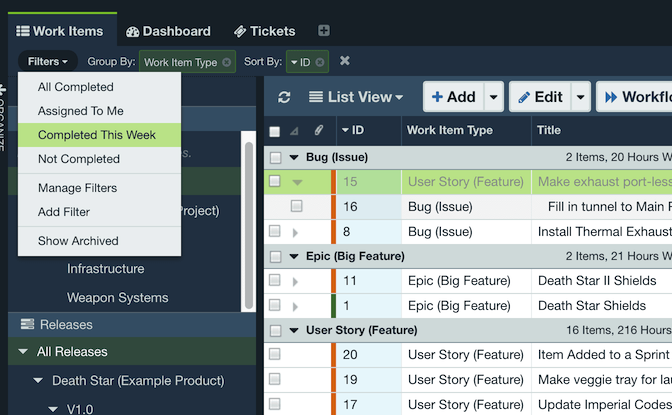
There are two categories of basic filters for Axosoft items: public filters and private filters. Public filters are intended for use by all users, while private filters are intended to be used solely by the creator of the filter. Axosoft provides a number of built-in public filters by default.
In addition, users with sufficient security rights can create new public filters for everyone to access.
Private filters are created by a user for their own needs. No one else can access the filter or use it. If a user has the security rights to do so, filters can be changed from private to public or vice versa by editing them.
Removing filters
Uncheck the box to temporarily disable your filter. If you no longer need the filter, click the icon to remove it from the Filter Bar.

Creating a new filter
Click on the Filters dropdown and then select Add Filter to create a new filter. You can also edit any existing filters from here by clicking on Manage Filters.
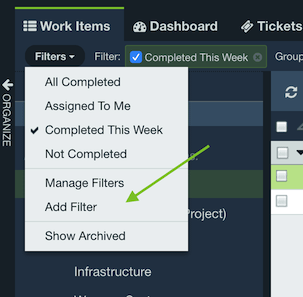
Filter Options
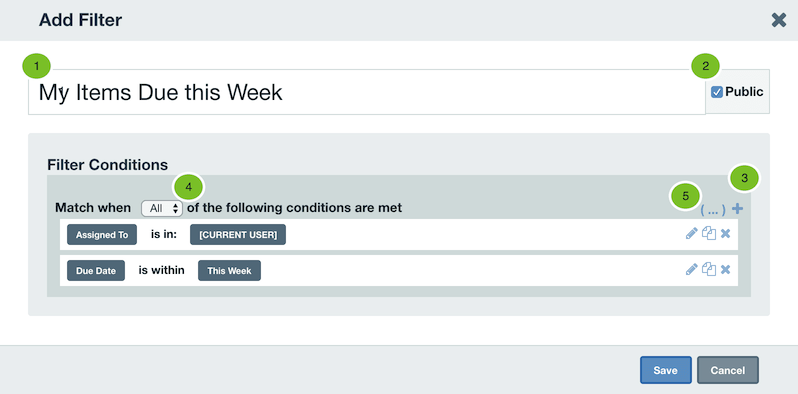
- Name the filter
- Make the filter public or private (all users can make private filters for their own purposes, but security roles with the ability to make public filters can create a filter to share with others)
- Add a new filter condition
- Select if “All” or “Any” of the conditions would need to be met (similar to AND and OR logic)
- Add a new group of conditions
Options for conditions
For user fields like [ASSIGNED TO], [CREATED BY], etc., you can use the option for any of the other default user fields as well as [CURRENT USER] and [CURRENT USER TEAMS].
For text fields like title and description, you can use the _ and % wildcard to match any words or characters within the condition result. The_ (underscore) is the wildcard for a single character, and % (percent) is a wild card for 0 or more characters. For example, spr%t% would return both “sprint” and “sprite” in your results. spr_t% will not return “sprint” but will return “sprite” because there is only one character used for the wildcard.
To search for a string that is anywhere in the body of text, you would want to make sure to add a % before and after the term. (For example, to search for the word “lazy” in the sentence “the quick brown fox jumped over the lazy dog”, you would enter %lazy% for your filter.
Grouping filter conditions
You can group multiple conditions together to allow for loads of different logical combinations. This is just like using parentheses to group conditions together. To add groups, you can click on the (...) icon, and then add any conditions. You would want to make sure to select the “All” or “Any” operator for your particular group.
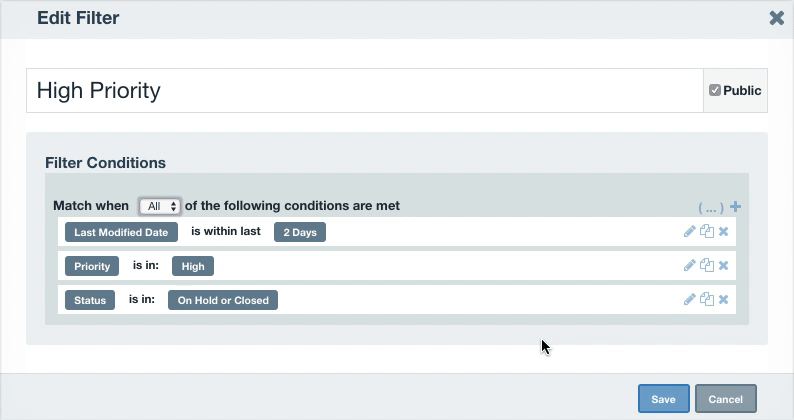
This example will return both High Priority items and items edited within 2 days and haven't been closed.
Edit existing filters
To edit, rename, copy, or delete existing filters, select Manage Filters from the Filters dropdown.

Quick filters
In the List View, you can also easily filter data using any list or date field. To add a quick filter, just mouse over the column header, and click on the Filter icon that appears on the right.
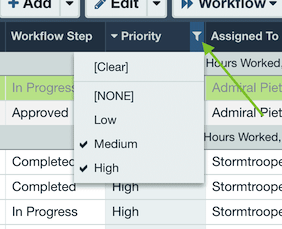
Custom multi-select list fields can also be quick filtered. Click each list value to filter items containing that value. Select Clear to remove the filter and any sorting on the column.
Searching Items
Axosoft's full text search provides results quickly and ranked in order of their relevance to a user's query. In addition to exact matches which appear as the top ranked results, Axosoft returns other “fuzzy” matches which are highly relevant, just like your favorite search engine does.
Here when we say “fuzzy” matches, we are referring to results which did not match the original query but were found to be highly relevant after relaxing the user's original search constraints. This relaxation works through a process called “stemming” which transforms the user's original search terms such that other inflectional forms of each term are also considered matches. For example, if you are searching for the word “attached” then Axosoft will also return items that use the form “attaches”, “attach”, “attaching” as well.
Some other helpful logic when using search are:
abc*= searches for any terms starting with "abc"+abc= exactly this form of the word“abc”= exactly this string-abc= without this stringnot abc= without this stringabc def= containing either term or bothabc and def= containing both termsabc or def= containing some form of either term or both<abc def>= containing some form of abc located near some form of defabc near def= containing some form of abc located near some form of defabc and (def or ghi)= containing some form of abc and either some form of def or ghi or both
Note: We no longer require you to surround your search with quotes in order to find exact matches. This is done automatically and exact matches will appear in the top ranked results.
Global Search

Global Search allows for the ability to widen search by toggling the Global Search button. Enabling global search will temporarily suspend all Filter by Selected filters active on the Organize Panel. To re-apply the filters, simply click the global search icon again.
For example, in a Work Items tab if there are certain bugs needing to be set into an upcoming release but are outside of the currently selected Project, Global Search can be enabled to locate it and then assign it to the release.
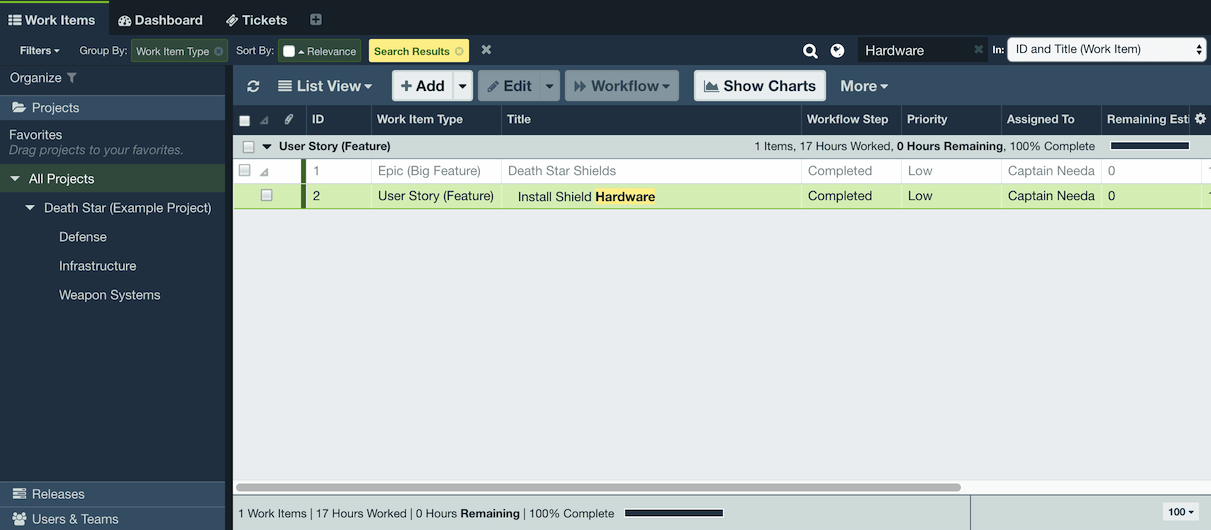
Once the item is found and updated, Global Search can be toggled off for the original filters to be restored.
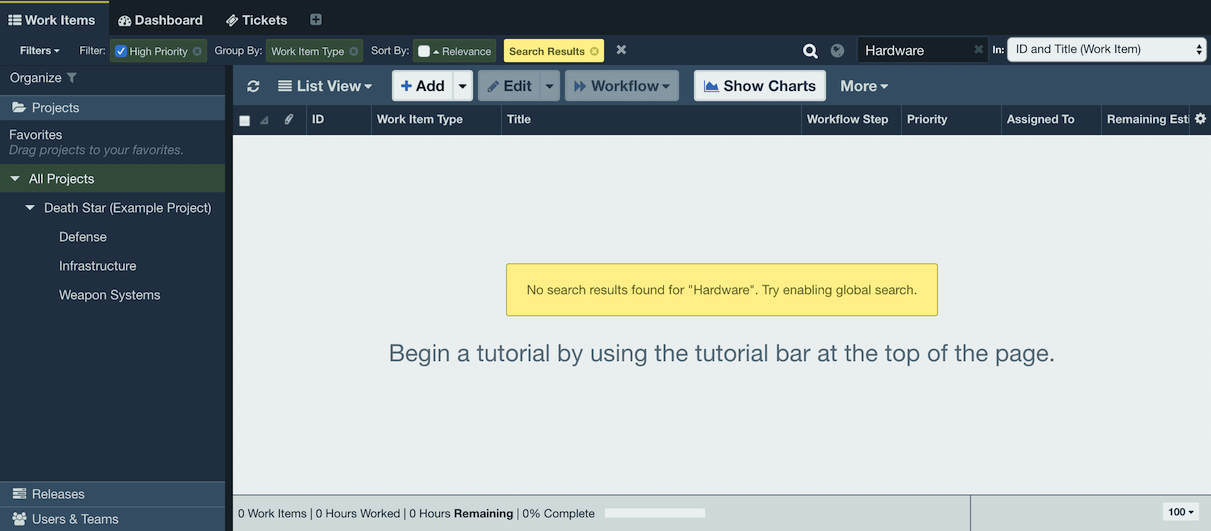
Note: Search on items is limited to the item type you are viewing and it is recommended using Global Search with an “All Items” tab.